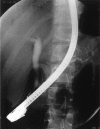Acinar cell carcinoma of the pancreas with and without endocrine differentiation
- PMID: 18332930
- PMCID: PMC2020533
- DOI: 10.1080/136518202760378452
Acinar cell carcinoma of the pancreas with and without endocrine differentiation
Abstract
Background: Acinar cell carcinoma (ACC) is a rare pancreatic neoplasm, representing 1% of exocrine tumours and containing a variable endocrine component. Three recent cases of ACC are reported.
Case outlines: A 72-year-old man with painless obstructive jaundice had a 5-cm mass in the head of pancreas resected by Whipple's operation; histopathological examination showed a typical ACC. A 33-year-old man with weight loss and abnormal liver function had a dilated biliary tree but no mass on imaging. Pylorus-preserving pancreatoduodenectomy was performed, and histology showed a mixed acinar-neuro-endocrine tumour. A 56-year-old man with weight loss and a palpable mass had a 15-cm mass in the distal body of pancreas, which was resected en bloc with the spleen and adherent stomach; it was a cystic ACC.
Results: Two patients are alive and free of disease at 30 months and 15 months, while the third patient with locally advanced disease died of myocardial infarction at 9 weeks.
Discussion: Acinar structures are the hallmark of this neoplasm, which carries a better survival rate than ductal cancer. Surgical excision prolongs survival and offers the best chance of cure.
Figures
References
-
- Klimstra DS, Heffess CS, Oertel JE, Rosai J. Acinar cell carcinoma of the pancreas: a clinicopathological study of 28 cases. Am J Surg Pathol. 1992;16:815–37. - PubMed
-
- Klöppel G, Morohoshi T, John HD, et al. Solid and cystic acinar cell tumour of the pancreas. Virchows Arch A Pathol Anat Histol. 1981;392:171–83. - PubMed
-
- Chen J, Baithun SI. Morphological study of 391 cases of exocrine pancreatic tumors with special reference to the classification of exocrine pancreatic carcinoma. J Pathol. 1985;146:17–29. - PubMed
-
- Morohoshi T, Held G, Kloppel G. Pancreatic tumors and their histological classification: a study based on 167 autopsy and 97 surgical cases. Histopathology. 1983;7:645–61. - PubMed
-
- Morohoshi T, Kanda M, Horie A, et al. Immunocytochemical markers of uncommon pancreatic tumours. Cancer. 1987;59:739–41. - PubMed
LinkOut - more resources
Full Text Sources
Research Materials



